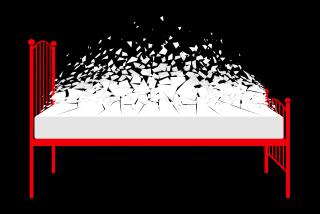LINENS : The Sensitive Rest Easy on Chemical-Free Sheets
- Share via
Printed, swirling, vibrantly colored bedsheets may be a decorator’s dream, but to Mary Lamielle they are nothing short of a nightmare.
If she sleeps on them, she gets a burning feeling in her nose and lungs; her skin feels hot, and she may get a rash and a headache.
To Lamielle, beige is beautiful, the kind of beige you get with cotton that is unbleached, undyed, untreated.
Luckily for her, simple nature is re-emerging as a force in a world long dominated by brighter-than-life blossoms and Day-Glo graphics.
Bed and bath retailers have started offering a growing selection of sheets, towels and other products made from untreated, all-natural fabrics. Once nearly impossible to find, these products now are manufactured by such major American mills as Fieldcrest Cannon and Westpoint Stevens. They can be found in mail-order catalogues--such as Garnet Hill, Cuddledown of Maine and Coming Home (a subsidiary of Lands’ End)--as well as bed and bath specialty stores and upper-end department stores.
“It’s gratifying to see what’s happening with marketing of less-toxic products. There are more options,” said Lamielle, who developed a serious sensitivity to chemicals in 1979 and has since had to make her home in Voorhees, N.J., as chemical-free as possible. In 1986 she founded the National Center for Environmental Health Strategies, a nonprofit education and advocacy organization.
The market for these untreated products, which are relatively expensive, is growing but still small--perhaps 2% to 5% of their bedding sales, manufacturers and retailers estimate.
Regular sheets usually are treated with chlorine or peroxide bleaches, starches, dyes, resins and formaldehyde.
Those chemicals even out fabric irregularities, create pleasing colors and patterns, set the dyes and keep the sheets from shrinking or wrinkling. For all those reasons, chemically treated sheets are bound to remain popular.
John Fraley, vice president of department and specialty stores for Westpoint Stevens, says the market for these products consists primarily of either “upscale, very well-educated consumers or someone who specifically has an allergy problem.”
“It used to be a narrow market, and now it’s a much broader market,” said Christopher Bradley, president of Cuddledown of Maine. “It’s consistent with the general awareness with the environment that has taken place over the past five to 10 years.”
The development of chemically untreated products has dovetailed with a fashion trend toward more natural colors and more emphasis on comfort, Bradley added. “When you don’t bleach or dye fabric, it becomes very soft,” he said.
Manufacturers are becoming increasingly creative about making untreated products more attractive. They have created stripes and patterns by using different weaves and darker and lighter shades of untreated cotton and linen.
The latest innovation in the all-natural market is color, not from dyes but from subtle hues that develop naturally right in the cotton or flax boll.
Untreated cotton has always been available in a range of colors, but the white variety was used commercially because its strength and quality was best suited for commercial processing and it could be dyed any color, explained Sally Fox, an Arizona cotton researcher.
Fox has developed her own breed of naturally colored cottons of commercial quality, called Fox Fibre. Colored breeds also are being developed in Israel.
Fieldcrest Cannon started marketing the first Fox Fibre products two years ago in light brown. This fall the company is offering a line of Israeli-made sheets called Colorcot that uses browns and greens in stripes and plaid.
Fox, who does her research at a 50-acre facility in Arizona, sees a potential to breed all the colors that occur naturally in the cotton plant, from ebony to redwood to yellow, and says even a blue may be possible. An added advantage of the brown shade, Fox added, is that, for reasons still unknown, it is naturally very fire resistant.
Untreated products are expensive. Cuddledown of Maine sells untreated cotton sheets for $20 per double flat or fitted, while Garnet Hill’s 310-thread double flat or fitted sheets go for $68 apiece. Fieldcrest Fox Fibre double sheets were recently selling for $24 apiece at department stores.
Manufacturers say it costs more to make the chemical-free products because they require special handling, including double- and triple-cleaning equipment to remove chemical residues, and because the items must be cut bigger to allow for shrinkage.
Fox predicts that once production is done on a larger scale, manufacturers will save considerable money in dyes, and untreated cotton will become “not only the environmental choice but the economical choice.”
“It’s also for people who like the idea of using renewable and reusable fabric rather than some of the bulletproof synthetics, (that) go to the landfill and never die,” said Louise Kosta of the Human Ecology Action League.
Sleeping is a time when the body is supposed to recover from the stresses of the day, not to fight off more chemicals, Kosta said. “It’s a comfort choice; it’s a health-related choice, it’s an environmental choice.”
More to Read
Sign up for Essential California
The most important California stories and recommendations in your inbox every morning.
You may occasionally receive promotional content from the Los Angeles Times.










